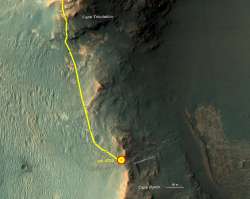NASA Mars Rover reaches the fluid-carved Valley to study its origin
Currently on its 2-year extended mission to study the origin of the fluid-carved valley, NASA Mars rover ‘Opportunity’ has finally reached its vital destination.

Currently on its 2-year extended mission to study the origin of the fluid-carved valley, NASA Mars rover ‘Opportunity’ has finally reached its vital destination.
As the rover approached the upper end of “Perseverance Valley” in early May, scientists received greater resolution images about the area, compared to the ones they received through satellites.
The process that carved Perseverance Valley into the rim of Endeavour Crater billions of years ago has not yet been identified.
It might have been flowing water, or might have been a debris flow in which a small amount of water lubricated a turbulent mix of mud and boulders, or might have been an even drier process, such as wind erosion.
The mission's main objective with Opportunity at this site is to assess which possibility is best supported by the evidence still in place, NASA said.
The rover team's plan for investigating the area begins with taking sets of images of the valley from two widely separated points at that dip in the rim.
"The long-baseline stereo imaging will be used to generate a digital elevation map that will help the team carefully evaluate possible driving routes down the valley before starting the descent," said Opportunity Project Manager John Callas of JPL.
The valley extends down from the rim's crest line into the crater for a distance of about two football fields.
Reversing course back uphill when partway down could be difficult, so finding a path with minimum obstacles will be important for driving Opportunity through the whole valley.
Researchers intend to use the rover to examine textures and compositions at the top, throughout the length and at the bottom, as part of investigating the valley's history.
Opportunity and the next-generation Mars rover, Curiosity, as well as three active NASA Mars orbiters and surface missions to launch in 2018 and 2020 are all part of ambitious robotic exploration to understand Mars, which helps lead the way for sending humans to Mars in the 2030s.
The mission has begun its 150th month since the early 2004 landing of Opportunity. In the first three months, which were originally planned as the full length of the mission, it found evidence in rocks that acidic water flowed across parts of Mars and soaked the subsurface early in the planet's history.
For nearly half of the mission Opportunity has been exploring sites on and near the western rim of Endeavour Crater, where even older rocks are exposed. The crater spans about 22 kilometres in diameter.
In mid-April it finished about two-and-a-half years on a rim segment called "Cape Tribulation.